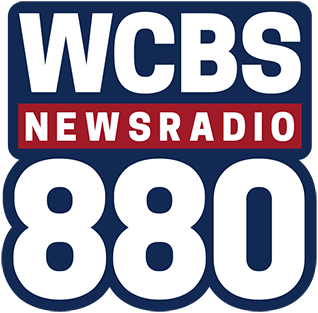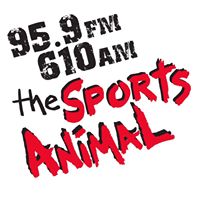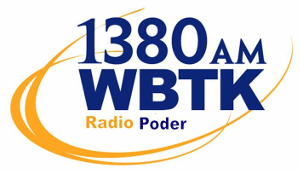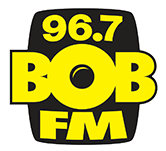
WCBS is a radio station licensed to New York, New York and is owned and operated by Audacy, Inc. WCBS's studios are located in the combined Audacy facility in the Hudson Square neighborhood of lower Manhattan and its transmitter site is located on High Island in the Bronx. Its 50,000-watt clear channel signal can be heard at night throughout much of the eastern United States and Canada.

WKBF was a radio station licensed to Rock Island, Illinois, which last carried a regional Mexican format. The station's frequency was 1270 kHz, and was broadcast at a power of 5 kW. It last broadcast in Autumn 2018, and its license was cancelled on June 1, 2020. Its transmitter was located on 22nd Avenue in Moline, alongside the Moline–East Moline border just off 53rd Street and Avenue of the Cities.

WADO is a commercial radio station licensed to New York City. It is owned by Latino Media Network. It broadcasts a Spanish-language sports radio format.

WZRC, known on-air as "AM1480", is a radio station licensed to New York City. The station is owned by Multicultural Broadcasting and airs Cantonese programming. It is one of two Cantonese radio stations serving the New York metropolitan area, the other is Chung Wah Chinese Broadcasting Company. WZRC's transmitting facility is located in Ridgefield Park, New Jersey.

WHP is a commercial AM radio station licensed to Harrisburg, Pennsylvania, serving the Harrisburg metropolitan area of South Central Pennsylvania. It broadcasts a talk radio format and is owned by iHeartMedia, Inc. The studios are on Corporate Circle in Harrisburg, off North Progress Avenue.
WYCK is a radio station that is owned by Bold Gold Media. Licensed to the city of Plains, it serves the Wilkes-Barre/Scranton radio market and broadcasts with 810 watts, non-directional.

WDBZ is an urban talk/urban contemporary-formatted radio station serving Cincinnati, Ohio. The station mostly plays urban talk while also providing urban oldies and urban contemporary gospel music. Owned by Urban One, its studios are located at Centennial Plaza in Downtown Cincinnati and the transmitter site is in Eden Park.

WMBD is a commercial AM radio station. It is the oldest station in the Peoria, Illinois, area. It broadcasts a news/talk format and is owned by Duke Wright with the license held by Midwest Communications, Inc. The radio studios and offices are on Fulton Street in Peoria. The WMBD transmitter site is located on County Road 2100 East in Groveland Township, Illinois. The station is powered at 5,000 watts, with a directional signal. By day, a two-tower array is used, switching to a four-tower array at night to avoid causing interference with other stations.

KNML is a sports talk formatted radio station owned by Cumulus Media and licensed to Albuquerque, New Mexico. Its studios are located in Downtown Albuquerque and it utilizes daytime and nighttime transmitters that are located within yards of each other in the southwest quadrant of the city, between the Rio Grande and the Albuquerque International Sunport.

WBTK is a Spanish religious formatted broadcast radio station licensed to and serving Richmond, Virginia. WBTK is owned and operated by Mount Rich Media, LLC.

WTAX is a commercial AM radio station in Springfield, Illinois. It is owned by Saga Communications, and operates as part of its Capitol Radio Group. WTAX simulcasts a news/talk radio format with 93.9 WTAX-FM. The radio studios and offices are on East Sangamon Avenue in Springfield.

WCVS-FM is a commercial radio station licensed to Virden, Illinois, and serving the Springfield metropolitan area. It broadcasts an adult hits radio format, branded as "96.7 BOB FM." The station is currently owned by Neuhoff Corp., through licensee Neuhoff Media Springfield, LLC.
WIBA is a commercial AM radio station licensed to Madison, Wisconsin. Owned by iHeartMedia, the station airs a Conservative Talk format, under the slogan "Madison's News/Talk Station."

WCLO is a radio station broadcasting a news–talk format. Licensed to Janesville, Wisconsin, United States, the station serves the Janesville area. The station is currently owned by Benjamin Thompson and features programming from CBS News Radio, Genesis Communications Network, Premiere Networks, Radio America, USA Radio Network, and Westwood One.
KSGF is an AM radio station licensed to serve Springfield, Missouri, United States. The station, which launched in 1926 as KGBX, is owned by SummitMedia. The station is also simulcast on 104.1 FM, which is licensed to Ash Grove, Missouri, United States.

WJOL is a radio station broadcasting a news talk/sports format. Licensed to Joliet, Illinois, United States, the station is currently owned by Alpha Media, through licensee Alpha Media Licensee LLC. WJOL carries a variety of local programming, as well as nationally syndicated shows. WJOL's studios are located in Crest Hill, and its transmitter site is in Joliet.

WSOY is a commercial AM radio station broadcasting a Talk radio format. Licensed to Decatur, Illinois, the station is owned by Neuhoff Corp., through licensee Neuhoff Media Decatur, LLC. Neuhoff owns four other local radio stations, WCZQ, WDZ, WDZQ and WSOY-FM. Studios and offices are located on North Water Street and the transmitter site is near St. Louis Bridge Road, sharing the same tower as WDZ.

WTAD is a radio station broadcasting a news talk format. Licensed to Quincy, Illinois, the station is owned by STARadio Corporation.
Portable broadcasting stations in the United States was a category of AM band radio stations, which were not restricted to operation in a specific community, but instead were permitted to be transported for broadcasting from various locations. These authorizations began in the early 1920s during a period when radio regulation in the United States was the responsibility of the Department of Commerce. However, after the newly formed Federal Radio Commission (FRC) took over in early 1927, it was decided that allowing stations to make unrestricted relocations was impractical, and in 1928 the FRC announced that existing portables that had not settled into permanent locations would be deleted. Station owner C. L. Carrell attempted to overturn the new policy, but was unsuccessful.
WLWL was a noncommercial radio station in New York City. It was operated by the Paulist Fathers, with its main goal being "the spread of Catholic truth and culture". WLWL began broadcasting in September 1925, and was sold in 1937, becoming WBIL. WBIL in turn was deleted in 1939, as part of a consolidation that resulted in an upgrade for station WOV.













